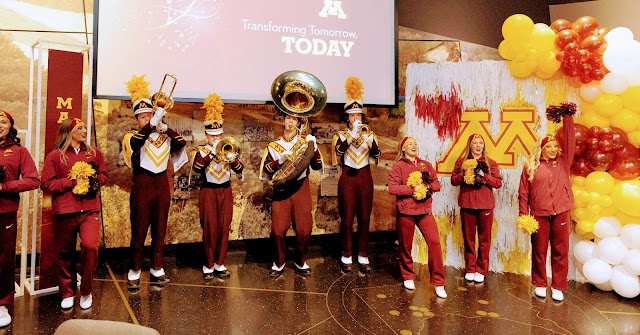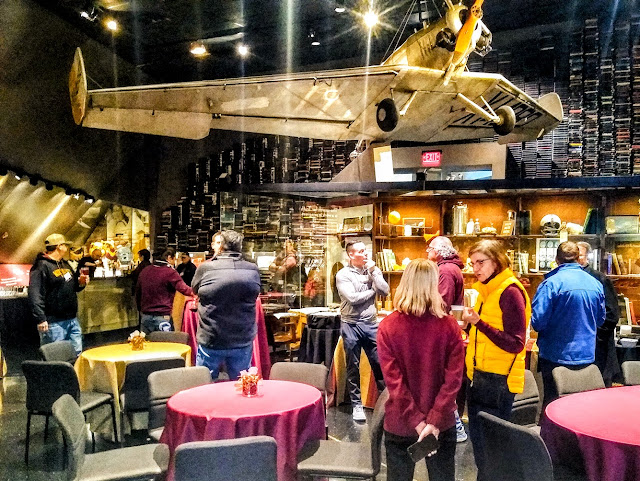November 23, 2024, was a special day of celebration and
of honoring the powerful collaboration between the University of Minnesota,
Minnesota Masonic Charities, and the Masons of Minnesota.
Minnesota Masonic Charities proudly
announced a transformative gift of 35 million dollars to usher in a new era of
discovery and advancement in cancer research, children’s health and healthy
aging.
The day’s festivities began with an indoor tail gate
party held in the Heritage Gallery at the University’s McNamara Alumni Center.
At first, I was a little
apprehensive not knowing what to expect from an indoor tailgate party. The idea
was unfamiliar but intriguing, however, my concerns quickly faded when I
realized I would not have to deal with the logistical nightmare of schlepping
my 120-quart Igloo cooler, folding chairs, and a grill in 30-degree weather.
This event promised to be more comfortable.
Upon arrival at the entrance to the Heritage Gallery we had to pass thru the Arch from the Memorial Stadium that stood on campus from 1924 to 1992. For me, it was reminiscent of my campus days attending football games in the Old Brickyard.
The Heritage Gallery is a large space, of contemporary
design, which serves as a museum like space. As a visitor you experience a
visual journey of exhibits, photos, artifacts that tell the story of the
University of Minnesota’s long-standing legacy.
The relationship between the University of Minnesota and
the Masons of Minnesota has been in place for over 70 years, so it seemed a
very fitting place for us to gather.
As we gathered in the warmth of
the Heritage Gallery, the indoor setting allowed for relaxed socializing, with
no worries about the cold or the logistical hurdles. Meaningful conversations
with doctors, clinicians, scientists, researchers and foundation people flowed
easily and bonds strengthened as we connected over our shared goals. It was a
day of celebration not just for a hopeful victory over Penn State, but a
powerful partnership that benefits our citizens in Minnesota and beyond our
borders.
One of the exhibits in the gallery is a wall of books
that extended from the floor to ceiling about fourteen feet high. It was quite
a conversation piece for a few of us bookworms. I was told the collection is
8,000 books that have been written by faculty, staff and former students from
the University of Minnesota. It was quite an impressive site. If you look
carefully, you can see the wall of books in the background of some of the
photos.
The Heritage Gallery was decorated in the traditional
maroon and gold sprite which created a mixture of excitement, especially when
paired with the anticipation of the football game later. There was even a
band ensemble that played the Gopher Rouser song that all could sing.
 |
| Photo by University of Minnesota |
The indoor tail gate party
blended the excitement of a regular Gopher football game day with the
underlying thrill of celebrating Minnesota Masonic Charities significant
donation.
In the back of the room were tables heavily laden with “healthy” tailgate food that added to the festivities. This was not your typical brats and burgers, and I found the food to be fresh, healthy, and full of flavor. I especially enjoyed the chili and consumed several bowls.
Since Dr. Jakub Tolar, the Dean of the Medical
School, and his staff were key attendees I guess I shouldn’t have expected to
be eating chili cheese fries, fried pickles and Snickers candy bars.
In the cookie photo, from left to right are the
following:
M
Health Fairview Masonic Children’s Hospital
University
of Minnesota Row the Boat
Masonic
Cancer Hospital
Compass
and Square in the Minnesota Masonic Charities Colors.
There were several speakers who shared their thoughts
about the partnership as well as profound thanks for the Mason’s continued
support of the University.
 |
| Photo by University of Minnesota |
Kathleen M. Schmidlkofer, the President, and CEO of the
University of Minnesota Foundation, praised the relationship as “70 years of
unwavering tradition of giving”. She praised Minnesota Masonic Charities and
the Minnesota Masons as having “bold and visionary leadership” and noted that
together we are building something extraordinary Transforming Tomorrow Today.
Our CEO of Minnesota Masonic Charities John Schwietz said in his comments: "Minnesota Masonic Charities has been a proud partner of the University of Minnesota Medical School for more than six decades, beginning with the opening of the first Masonic Memorial Cancer Hospital in 1958,” he went on to say. “Our commitment to advancing cancer research and care has expanded over the years to include a focus on children's health and wellness, reflecting our belief in the importance of caring for individuals across every stage of life. Now, with the naming of the Masonic Institute on the Biology of Aging and Metabolism, we are honored to come full circle, returning to our roots in supporting the aging population—a mission that began more than a century ago with the founding of the Masonic Home. We look forward to the continued impact of this extraordinary partnership."
 |
| Photo by University of Minnesota |
Dr. Rebecca Cunningham, President of the University of
Minnesota, spoke about the deep and lasting relationship between the
institutions and how both want to do something important. She noted that the
University and the Masons possess the same shared values and then compared
those values with the current inspirational mantra on campus of “Row the Boat.”
“Row the Boat” is the motivational phase authored by the
Head Football Coach of the University of Minnesota P.J. Fleck. Coach Fleck uses
“Row the Boat” to inspire his players, and it emphasizes the importance of
teamwork, perseverance, and focusing on the present moment. It is a powerful
reminder to keep moving forward, no matter what challenges are met with.
Afterwards Kathleen Schmidlkofer and Dr. Rebecca
Cunningham presented CEO Joh Schwietz with a boat paddle signed by Coach Fleck
as a memento to honor this wonderful day.
Following the tailgate party, we bundled up and made our
way across the street to Huntington Bank Stadium to watch the Minnesota versus
Penn State Football game.
 |
| Photo by University of Minnesota |
Each attendee was presented with a Row the Boat stocking
cap, and hand warmers to help keep warm during the game and as a memento-gift
of the day’s celebration. A Minnesota outdoor football game in November
can be chilly!!
 |
| Grand Master Foster Solem, John Schweitz, Dr. Jakub Tolar, Dr. Rebecca Cunningham, Kathleen Schmidlkofer |
The highlight of the day occurred on the field at half
time, when John Schwietz, CEO of Minnesota Masonic Charities, presented a check
for thirty-five million dollars to Dean Jakub Tolar, President Rebecca
Cunningham, and Kathleen Schmidlkofer representing the University of Minnesota
Medical School, and the University of Minnesota Foundation.
The University recognized this incredible contribution
and expressed that this gift will undoubtedly pave the way for new discoveries
and advancement in Cancer, Children’s health and Healthily Aging. That will
benefit all Minnesotans and to those beyond our borders.
For me personally this was more than just a special day
of celebration. It was a heartfelt recognition of our deep and lasting
relationship and of our shared vision and combined efforts that drive our
partnership. The powerful teamwork between the University of Minnesota,
Minnesota Masonic Charities, and the Masons of Minnesota has already achieved
wonderful things in the past, and the future even looks brighter with our
continued support and dedication.
I would like to personally thank the University of
Minnesota Foundation for access to their photo collection of the days event,
and permission to use them for my blog posts.
 |
| Photo by University of Minnesota |
 |
| Photo by University of Minnesota |






























